FRANK MARTIN (1890-1974)
The orchestral series on CHANDOS from London Philharmonic Orchestra conducted
by Matthias Bamert (recorded 1993-1995).
BIOGRAPHICAL PROFILE
With a name like Frank Martin you might innocently leap to the conclusion
that Martin is yet another British composer. In fact Martin (whose name is
approximately pronounced Fronk Martan) was born in French-speaking
Geneva, the tenth child of a Calvinist family.
He had no conservatoire training being privately-taught by one Joseph Lauber.
He developed quickly as both pianist and composer. At the age of ten he heard
Bach's Matthew Passion - a watershed experience witness his choral
writing. In 1918 he met the conductor Ernest Ansermet who leavened this
Protestant Alpine stream with Mediterranean doses of fraîcheur from
Debussy and Ravel. Later he taught rhythmic theory at the Dalcroze Institute
before a move to the Netherlands and ultimately to Köln Conservatory.
His music found some welcome in the 1940s but struggled against the atonal
spirit of the times during the 1950s to 1970s.
FRANK MARTIN
Der Sturm (1954) - Overture; Mein Ariel, hast du, der Luft nur ist;
Ein feierliches Lied
Hin sind meine Zauberei'n
Maria-Triptychon (1968)
Six Monologues from Jedermann (Everyman)
(1943)
 Linda Russell (sop)
Linda Russell (sop)
David Wilson-Johnson (bar)
Duncan Riddell (violin)
London PO/Matthias Bamert.
rec Blackheath Concert Halls, London 26-27 Sept 1994
 CHANDOS CHAN 9411
[68.22]
CHANDOS CHAN 9411
[68.22]
Crotchet
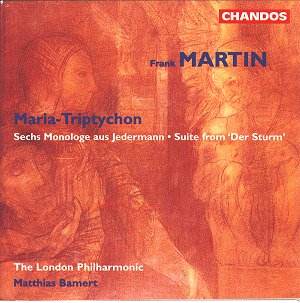
The Tempest, not surprisingly, holds a magical enchantment for composers.
Martin's music for Der Sturm (drawn from an opera on Shakespeare's
'The Tempest' and following, in a continuous setting, the translation by
A W von Schlegel) fulfils high hopes. Its translucent murmur (Eugene Goossens
By The Tarn), its otherworldliness (Holst's Neptune), its dash
and explosive assaults, its anger - all these are only undermined by a vocal
part of protesting declamation. The work comes full circle at the close in
a quiet instrumental murmur.
Maria Triptychon was written for wife and husband Irmgard Seefried
and Wolfgang Schneiderhan (whose fine recording of the Martin violin concerto
is on Decca). Seefried and Schneiderhan's recording of the triptych is on
Jecklin Disco mono JD645-2. The style of the work is one of acid tenderness
with the orchestra back-dropping the two principal players. An insistent
violin solo dances in dependent adoration (as a pilot fish to a shark) around
the voice as its tracks through the 'trois parties' of Ave Maria;
Magnificat; Stabat Mater. The violin line's contentment drinks
reverentially from the same source as the Beethoven violin concerto. Such
serenity cannot be matched by the vocal part. The violin acts as a
continually-in-motion 'sheet anchor'. The violin can express neurotic irritation
as well but serenity is in the dominant.
The Jedermann music encompasses in its Bergian lyricism the slow mournful
spell of the bassoon and the rhythmic grimoire such a hallmark of Welsh composer,
Grace Williams. The male singer produces an effect recalling Das Lied
von der Erde. This is astringent music with a hint of alkali corrosive
about it. Frank sets Hugo von Hoffmansthal's words from the play 'Jedermann'.
Both the Jederman and the Der Sturm extracts have been recorded
before by the Berlin Phil conducted by the composer on DG 20th Century Classics
429 858-2GC.
Triptychon stands out in this company though reputedly not effacing
memories of Seefried and Schneiderhan's 1960s recording.
Rob Barnett

FRANK MARTIN
Ballades
Ballade for Piano and Orchestra (1939)
Ballade for Trombone, Piano and String Orchestra (1939)
Ballade for Cello and Small Orchestra (1949)
Ballade for Saxophone and Orchestra (1938)
Ballade for Viola, Wind, Harp, Harpsichord and Percussion (1972)
Ballade for Flute, Piano and String Orchestra (1939)
 Celia Chambers (flute)
Celia Chambers (flute)
Martin Robertson (sax)
Ian Bousfield (trombone)
Philip Dukes (viola)
Peter Dixon (cello)
Roderick Elms (piano/harpsichord)
Rachel Masters (harp)
London PO/Matthias Bamert.
Rec Goldsmiths College, London 4-6 Jan 1994
 CHANDOS CHAN 9380
[76.48]
CHANDOS CHAN 9380
[76.48]
Crotchet
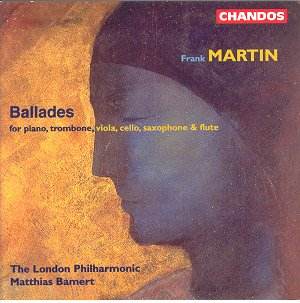
The collection of Ballades is, for me, the 'Prince' among these five
Chandos discs. Substantial single movement essays provide an ideal medium
for Martin's Lutheran-tempered (if not subdued) voice. When he uses voices
(especially solo singers) he can tend towards an unvariegated recitative
as the story is told. This can infer monotony. The Piano Ballade is
typically subtle with overtones of Ravel and a dramatic smash and swing to
its finale. The Trombone accentuates the chansonnier rather than the buffoon
in its short and lyrical episode.
Do not look for an unbridled ecstasy in Martin. His religious convictions
(manifest in the music) do not permit the sort of religious exaltation that
crosses the divide into fleshly joys. Martin might thus be compared to Herbert
Howells but a Howells with a sombre Gallic accent and purged of the Delian
abandon that shakes the rafters and galleries in Missa Sabrinensis and
Hymnus Paradisi.
The Cello Ballade could easily partner Edmund Rubbra's Soliloquy
and Nicolas Flagello's Capriccio (1962) both for cello and
orchestra. It is given a rhythmic jolt by an ostinato that Martin may have
encountered in Sibelius's Nightride and Sunrise. The shades are Dutch
Master ochres and are perfectly matched to the natural tones of the cello
and its inclination to profundity and wonder.
The tightly bunched French tone of the solo in the Saxophone Ballade
is contrasted with string writing taking us to the chillier passages in
Shostakovich's Eighth Symphony. The Viola Ballade's accents are oriental
with a dash of Stravinsky along the way - perhaps a linkage with
Pribaoutki and the Japanese Songs. The neatly chiselled Flute
Ballade adopts a Ravel-like approach and mixes it with the engaging
chatter of Nielsen's Flute Concerto.
Decca have recorded some of the Ballades before. Those for Piano, Trombone,
Saxophone and Flute are coupled with the Concerto for Seven Wind Instruments,
Timpani, Percussion and Strings on Decca 444 455-2DH. The Royal Concertgebouw
are conducted by Riccardo Chailly. The solo team includes some of the most
celebrated virtuosos of the age including John Harle and Christian Lindberg
as well as Roland Brautigam.
The fact is however that Chandos have the most natural and generous of couplings
and this and the inherent musical values of the music and its performance
make this a preferred choice.
Rob Barnett

FRANK MARTIN
In Terra Pax (1944)
Les Quatre Éléments (1964)
 Judith Howarth (sop)
Judith Howarth (sop)
Della Jones (con)
Martyn Hill (ten)
Roderick Williams (bar)
Stephen Roberts (bass)
Brighton Festival Chorus
London PO/Matthias Bamert.
Rec Blackheath Concert Halls, London 15-16 Nov 1995
 CHANDOS CHAN 9465
[67.04]
CHANDOS CHAN 9465
[67.04]
Crotchet
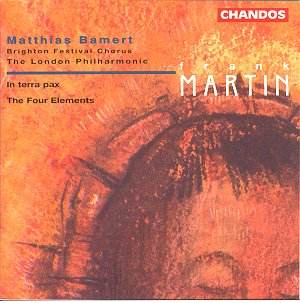
The musical portraits of The Four Elements (Earth, Water, Air, Fire)
are delineated by Martin as a sallow drama played in dark or darkening
pastels. The composer's sobriety sets the bounds for his imaginative approach.
There is none of the uproar and delirium to be found in Holst's music for
the Elements in his opera The Perfect Fool. Even so the aquamarine
seas and dark inky swirl are well put across pretypifying (by only one year
and presumably quite innocently) the early pages of Nystroem's Sinfonia
del Mare. The work has been recorded before by the Concertgebouw with
Bernard Haitink on Preludio PRL2147.
In Terra Pax was the work that first drew me towards Martin. This
was in the Ansermet/Decca version. It recreates apocalyptic visions of peace
achieved through loss and suffering as well as visions of ignorant armies
clashing by night. Bamert's quartet of singers is generally strong,
and render the original French idiomatically. In a 'head to head' I would
still prefer the Ansermet for the emotional cauldron it stirs. In Terra
Pax was written to mark the looming end of the Second World War. Martin
commented on how he rushed to complete the work seemingly racing the Allied
advance. The Chandos voices are presented across the soundstage in a well
contrived spread. While there are some pages of, what I will call Martin's,
Protestant recitative (usually given to solo singers) there is some truly
luminous writing for the massed choral forces. This is evocative of the Great
Carillon of Christmas; indeed bell effects run through this work. If you
do not know the piece think in terms (if you know it - as yet no commercial
recording) of Peter Racine Fricker's A Vision of Judgement and Franz
Schmidt's Book of the Seven Seals.
Second only to the Ballades disc this remains a strong contender in the
Martin-Chandos stakes.
Rob Barnett

FRANK MARTIN
Concerto for seven wind instruments, percussion and strings (1949)
Erasmi Monumentum (1969)
Etudes for string orchestra (1956)
 London PO/Matthias Bamert
London PO/Matthias Bamert
rec Goldsmiths College, London 9-10 July 1993
 CHANDOS CHAN 9283
[66.49]
CHANDOS CHAN 9283
[66.49]
Crotchet
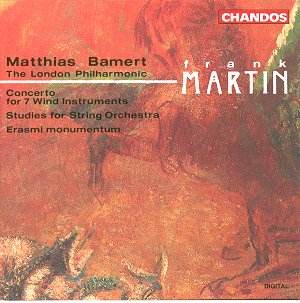
The Concerto for seven wind instruments, percussion and strings [21.29] was
premiered in 1949 and in its pawky humour owes somewhat to Stravinsky. The
soloists imbue it with its full meed of character. I single out Celia Chambers
for her delightful way with the flute part bringing out its relation with
the Nielsen Flute Concerto. Philip Tarlton's bassoon serenading is chortled
with great style. Ravel's Valse flickers alight at 5.23 in the
Allegro but the second movement (typically of calmer character), in
fact, is quite troubled among the undoubted elegance. A sour darker
note recalls Kurt Weill's wind writing. The Allegro Vivace is lively
and the trumpet's roulades even suggest a Genevan Arnold but there is yielding
emotion as well as an anxious glance cast over the shoulder. Nightmares from
the last war were still alive. The work was premiered in 1949.
The Studies for String Orchestra (1956) [20.47] was given its first
performance by the insatiable Paul Sacher many of whose commissioned works
have formed mainstays of the repertoire. This work is clean of line, troubled,
varied and severe. There is a flighty tranquillo, a grandly satisfying
pizzicato (brilliantly recorded by Chandos) seeming to picture an orchestra
of wavering balalaikas in Spanish dress. The Allegro giusto is limber
but does not give way to any overt romance.
Erasmi Monumentum (1969) is scored for organ and orchestra. The title
reference is to Erasmus. The Homo pro se movement takes its title
from the name by which Erasmus was known by his contemporaries. Dignified
and slowly swelling its clean yet unglamorous counterpoint builds steadily.
The organ comments discreetly and ending all in an ocean of calm. The
Stulticiae Laus is almost knockabout - cackling and goading along
the way. Querela Pacis (plea for peace) does not shrink from protest
but its resolves into tranquillity. This was written, presumably, as a response
to Vietnam.
The recording quality is in the reliably pellucid Chandos house style for
the 1990s. This is an indispensable series neatly flanked by Richard Langham
Smith's notes.
These works are not similarly coupled on any other disc.
Rob Barnett

FRANK MARTIN
Symphonie concertante (1945)
Symphony (1937)
Passacaglia (1944)
 London PO/Matthias Bamert
London PO/Matthias Bamert
Rec Goldsmith's College 26-27 September 1993
 CHANDOS CHAN 9312
[67.17]
CHANDOS CHAN 9312
[67.17]
Crotchet
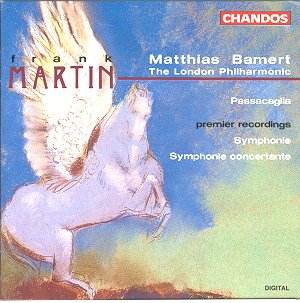
The four movement Symphony [31.45] is a work dating from two years
before the outbreak of the Second World War. It has something in common with
the Second Symphony of Kurt Weill though being less gawky and, at one level,
a more tranquil work. The premiere was given in Martin's native Geneva under
the baton of Ernest Ansermet but rapidly dropped out of the picture so far
as concert-hall attention was concerned. The work is inflected by a user-friendly
brand of serialism but the inflection is pretty gentle. The saxophone rises
from time to time out of the aural fabric as also do the two pianos played
by Roderick Elms and Ian Watson. Voice spotting: along the way splashes of
Stravinsky and Ravel but nothing to tempt you to slate the piece as hollowly
derivative. The Largo is cool, candid, subtle, of great emotive moment,
reflective and providing a secure centre of gravity for the work. The music
grows noticeably brighter (more candle-power) as it proceeds. The rush and
scrimmage of the scherzo still finds room for the lyrical side illumined
by vibraphone. The finale's opening shudder and piano display recalls Martinu's
Concerto for piano and double string orchestra. The clarinet's capering banshee
rolls take us back to Kurt Weill territory with hints also of Peter Mennin.
The much more famous Symphonie Concertante is a product of 1945 and
yet another Paul Sacher commission. There are several competing recordings.
The present recording is of the version for large orchestra - a version prepared
in 1946 from the Petite Symphonie. This work with its almost surreptitious
lyrical stance, its Bachian twists, and a string-band tread redolent of Roy
Harris, serious mien, its climax-building using qualities familiar from
Khachaturian and Grace Williams. There is a snappy Ravelian crackle and spit
in the contrasting Allegretto.
The Passacaglia has the same serious set to the jaw. Its relationship
to Bach is patent (4.48). Slatey and reticent lyrically speaking it is a
work of great concentration and unity. Something of Edmund Rubbra's reserve
hangs over its pages. Its little rippling motivic springs and slow string
band flourishes (especially the latter) take us deep into the pages of Rubbra
Fourth Symphony and even into Franz Schmidt's Second and Fourth Symphonies.
In an unhackneyed concert programme it would partner well with Constant Lambert's
similarly unconsidered Music for Orchestra (1927) and the single movement
First Symphony of John Veale.
The most intriguing and challenging of the Chandos Martin discs.
Rob Barnett

OVERVIEW
The look and feel of these five discs is considered, somehow four-square
with the music; displaying all the accustomed Chandos prestige values. The
covers take burnished ochre and blue slate detail from oils by Odile Redon.
OTHER RECORDINGS
The five Chandos CDs (all products of the 1990s) are at full price. As yet
there is no sign of a mid-price box or further instalments. One half expects
Chandos to come out with recordings of the concertos and the other major
choral or vocal works like Golgotha, Requiem and Le Vin
Herbé. Currently there is no reason to believe that this will
happen.
Outside the Chandos full price series there are other Martin CDs worth
considering. The foremost is the Decca twofer (Decca 448 264-2) which includes
the Septet Concerto, Etudes, Petite Symphonie and
Passacaglia (all Karl Munchinger's Stuttgart tapes) with the Violin
Concerto (Wolfgang Schneiderhan) and In Terra Pax. These latter are
conducted by Ansermet with the Suisse Romande. The soloists in In Terra
Pax are Ursula Buckel, Marga Höffgen, Ernst Haefliger, Pierre Mollet
and Jakob Stämpfli - a strong team. This collects stereo and mono recordings
(only the Passacaglia is mono) from the 1950s and 1960s including
some true classics.
At the same price level the Warner Ultima series (3984-24237-2) couples
Golgotha (a rare item) with the a cappella Mass.
Golgotha (sung in German rather than the native French) is also available
from VENGO 21.401.
We must not forget the Swiss company Jecklin that connoisseur among CD labels.
They offer an historic but very strong stereo of Le Vin Herbé.
This is on Jecklin-Disco JD 581/2-2 (2 CDs). This is a reissue of the 1961
Westminster 2LP set XWN-2232. Victor Desarzens conducts with 12 solo singers
(including Eric Tappy, Helen Morath, Heinz Rehfuss), an ensemble of seven
strings from the Winterthur Stadtorchester and the composer as pianist. A
lean recording of an authoritative interpretation. There is, I believe, a
much more recent recording on Dutch Philips (not heard by me).
A Suisse Romande radio tape of the Lausanne premiere was the source of Jecklin's
recording of the Requiem (Jecklin-Disco JD631-2). As a work this must
be counted in the same master category as In Terra Pax. This is conducted
by the composer in a performance that burns luminous and bright.
There are other collections on Deutsche Grammophon (Fiescher Dieskau in
Jedermann and Der Sturm) and Decca. These will be well worth
exploring.
The two Jecklins and the German language Golgotha have been reviewed
here before. If you use the site search engine you will find the reviews
easily.
The Chandos series complements these various releases rarely overlapping
completely (even the Decca collection of Ballades omits works included
on the Chandos disc.
There is much still to come. It would be good to hear the complete Der
Sturm as well as Poèmes de la Mort for three voices and
three electric guitars (1971), the cantata Pilate, Pseaumes de
Genève (mixed choir, children's voices and orchestra) La
Mystère de la Nativité (an oratorio), and the Die Weise
von Liebe und Tod des Cornets Christoph Rilke - a work for high voice
and orchestra - effectively an hour long song cycle.
